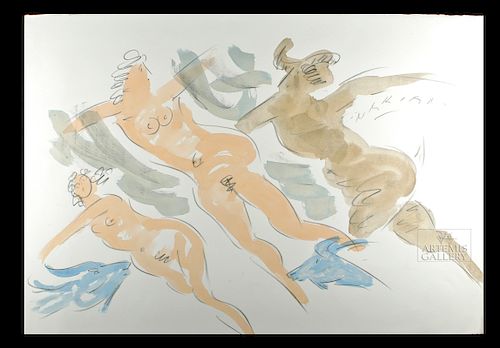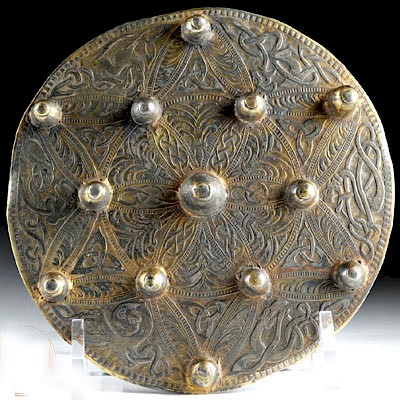Signed Reuben Nakian Watercolor, Three Graces - 1960s
Lot 146
About Seller
Artemis Gallery
686 S Taylor Ave, Ste 106
Louisville, CO 80027
United States
Selling antiquities, ancient and ethnographic art online since 1993, Artemis Gallery specializes in Classical Antiquities (Egyptian, Greek, Roman, Near Eastern), Asian, Pre-Columbian, African / Tribal / Oceanographic art. Our extensive inventory includes pottery, stone, metal, wood, glass and textil...Read more
Estimate:
$800 - $1,200
Absentee vs Live bid
Two ways to bid:
- Leave a max absentee bid and the platform will bid on your behalf up to your maximum bid during the live auction.
- Bid live during the auction and your bids will be submitted real-time to the auctioneer.
Bid Increments
| Price | Bid Increment |
|---|---|
| $0 | $25 |
| $300 | $50 |
| $1,000 | $100 |
| $2,000 | $250 |
| $5,000 | $500 |
| $10,000 | $1,000 |
| $20,000 | $2,500 |
| $50,000 | $5,000 |
| $100,000 | $10,000 |
| $200,000 | $20,000 |
About Auction
By Artemis Gallery
Jul 19, 2018
Set Reminder
2018-07-19 10:00:00
2018-07-19 10:00:00
America/New_York
Bidsquare
Bidsquare : Fine Antiquities/Ethnographic Art
https://www.bidsquare.com/auctions/artemis-gallery/fine-antiquities-ethnographic-art-3329
Featuring classical antiquities, ancient and ethnographic art from cultures encompassing the globe, plus fine art. Artemis Gallery info@artemisgallery.com
Featuring classical antiquities, ancient and ethnographic art from cultures encompassing the globe, plus fine art. Artemis Gallery info@artemisgallery.com
- Lot Description
Reuben Nakian (American, 1897-1986), "Three Graces", watercolor on BFK Rives paper, signed at upper right, ca. 1960s to 1980s. An outstanding, original watercolor depicting the Three Graces, the trio of female nudes depicted in varying flesh tones with swashes of blue in the background. Nakian was an American sculptor of Armenian descent who favored themes from Classical mythology. The Three Graces known in Greek mythology as Charites and in Roman mythology as Gratiae were goddesses of beauty, creativity, and charm. Indeed, Nakian has done them justice in this breathtaking composition. Size: 29.625" W x 20.75" H (75.2 cm x 52.7 cm)
In the 1920s and 30s, Nakian received considerable recognition with many exhibitions in New York, including the Whitney Museum of American Art, the Museum of Modern Art, the Downtown Gallery, the Wildenstein Gallery, the Art Institute of Chicago, and the Corcoran in Washington D.C. In 1926, he met Brancusi and assisted him in installing his first one-man exhibition in the United States. Frank O'Hara, curator of a retrospective at New York's Museum of Modern Art in 1966, wrote, "Nakian is unrepressed, un-neurotic, unabashed in his approach to sensuality, however tortuous his esthetic commitment, and whether his subject be death, bestiality, or Arcadian dalliance. This explicitness gives the 'Nymph and Satyr' plaques a marvelous joy and ease, the 'Europa' terra-cottas a voluptous dignity, and the 'Leda and the Swan' drawings an almost comic abandon. Unlike most sexually oriented images in modern art, from Auguste Rodin to Andy Warhol, one finds no guilt or masochism in a Nakian. It is outgoing and athletic even in its releases and defeats: the satyr, the bull, the swan, the goat are each circumvented or absorbed by the goddess of his choice in the most choice of circumstances, that of his own choosing, like the amorous 'dying' of the Elizabethans or the Metamorphoses of Ovid.
According to Grace Gluek who wrote Nakian's New York Times obituary, "The sculptor carried on an extraordinarily productive career until very recently, turning out work whose visionary nature was infused with a lively eroticism. His creations ranged from monumental sculptures to small tabletop pieces along with drawings, prints, pottery and book illustrations." Reviewing a Nakian show in 1977, the art critic Hilton Kramer wrote that its content was ''so quick and evocative, so obviously the expression of both a love of life and a love of art, that it holds us in its power from our first moment of contact and remains in the mind long afterward.'' https://www.nytimes.com/1986/12/05/obituaries/reuben-nakian-us-sculptor-dies.html
Gluek continued, "Working figuratively, Mr. Nakian saw himself, since the early 1950's, as a legatee of ancient Mediterranean tradition. His subject matter was heroic, largely drawn from Greek and Roman mythology, particularly the aspects that dealt with the erotic exploits of the gods. In 1951, a selection of 58 of his works represented the United States at the important Sao Paulo Bienal in Brazil, but he was something of an anachronism in the years of Pop and Minimalism, and he went his own way, unconcerned with contemporary trends. Later, in 1968, he was chosen among a rather unorthodox group of artists to represent the United States in the 34th Venice Biennale."
Born in College Point, New York, Nakian studied at Manhattan's Independent School of Art, the Robert Henri School, and the Art Students League with Paul Manship and his assistant Gaston Lachaise. Later in life, Nakian credited Cezanne and Brancusi as primary influences on his style. His friends included esteemed artists such as Arshile Gorky, Willem de Kooning, Marsden Hartley, and Marcel Duchamp. Nakian also taught at the Pratt Institute in New York as well as the Newark School of Fine and Industrial Arts. His work can be found in the collections of DeCordova Museum and Sculpture Park, Fogg Art Museum, Honolulu Museum of Art, Smithsonian American Art Museum, Hirshhorn Museum and Sculpture Garden, Solomon R. Guggenheim Museum, Whitney Museum of American Art, Los Angeles County Museum of Art, Nassau County Museum of Art, Neuberger Museum of Art, Oklahoma City Museum of Art, The Delaware Art Museum, University of Arizona Museum of Art, University of Michigan Museum of Art, Guilford College Art Gallery, Saint Joseph College Art Gallery, Nelson-Atkins Museum of Art, Sheldon Art Gallery, Walker Art Center, National Gallery of Australia, Portland Art Museum, and the Boca Raton Museum of Art.
Provenance: ex-Denenberg Fine Arts, Los Angeles, California, USA
All items legal to buy/sell under U.S. Statute covering cultural patrimony Code 2600, CHAPTER 14, and are guaranteed to be as described or your money back.
A Certificate of Authenticity will accompany all winning bids.
We ship worldwide and handle all shipping in-house for your convenience.
#136689Slight foxing to edges of the watercolor paper; gallery notes in pencil and foxing on verso - but overall, very good.Condition
- Shipping Info
-
All shipping is handled in-house for your convenience. Your invoice from Artemis Gallery will include shipping calculation instructions. If in doubt, please inquire BEFORE bidding for estimated shipping costs for individual items.
-
- Buyer's Premium



 EUR
EUR CAD
CAD AUD
AUD GBP
GBP MXN
MXN HKD
HKD CNY
CNY MYR
MYR SEK
SEK SGD
SGD CHF
CHF THB
THB














